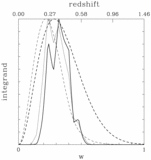Weak Lensing Study of Galaxy Biasing
Abstract
We combine weak lensing measurements from the Red-Sequence Cluster Survey (RCS) and the VIRMOS-DESCART survey and present the first direct measurements of the bias parameter b and the galaxy-mass cross-correlation coefficient r on scales ranging from 0.2 to 9.3h-150 Mpc (which correspond to aperture radii of 1.5‧-45') at a lens redshift z~=0.35. We find strong evidence that both b and r change with scale for our sample of lens galaxies (19.5<RC<21), which have luminosities around L*. For the currently favored cosmology (Ωm=0.3,ΩΛ=0.7), we find b=0.71+0.06-0.04 (68% confidence) on a scale of 1-2h-150 Mpc, increasing to ~1 on larger scales. The value of r has only minimal dependence on the assumed cosmology. The variation of r with scale is very similar to that of b and reaches a minimum value of r~0.57+0.08-0.07 (at 1h-150 Mpc; 68% confidence). This suggests significant stochastic biasing and/or nonlinear biasing. On scales larger than ~4h-150 Mpc, the value of r is consistent with a value of r=1. In addition, we use RCS data alone to measure the ratio b/r on scale ranging from 0.15 to 12.5h-150 Mpc (1'-60') and find that the ratio varies somewhat with scale. We obtain an average value of b/r=1.090+/-0.035, in good agreement with previous estimates. A (future) careful comparison of our results with models of galaxy formation can provide unique constraints, as r is linked intimately to the details of galaxy formation.
- Publication:
-
The Astrophysical Journal
- Pub Date:
- October 2002
- DOI:
- 10.1086/342228
- arXiv:
- arXiv:astro-ph/0206103
- Bibcode:
- 2002ApJ...577..604H
- Keywords:
-
- Cosmology: Observations;
- Cosmology: Dark Matter;
- Cosmology: Gravitational Lensing;
- Astrophysics
- E-Print:
- accepted for publication in ApJ 11 pages, 6 figures
